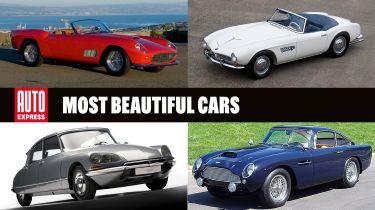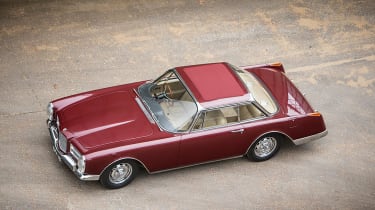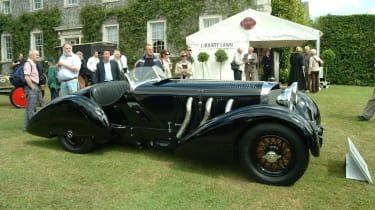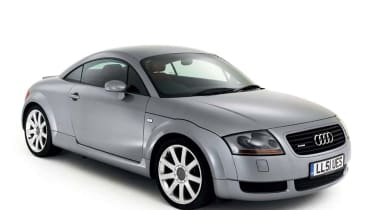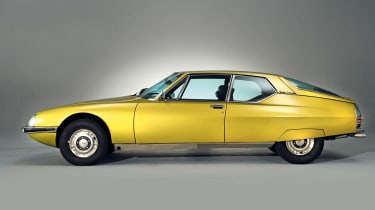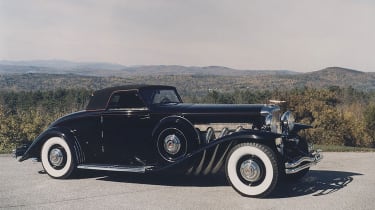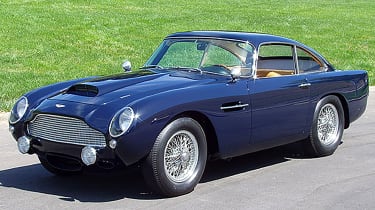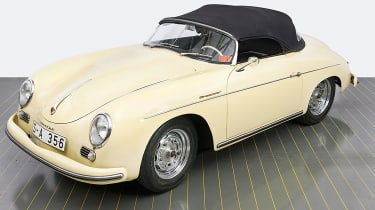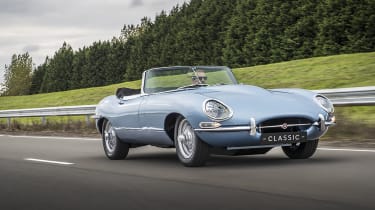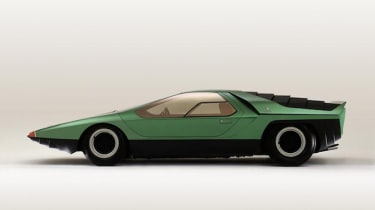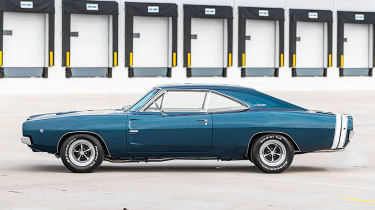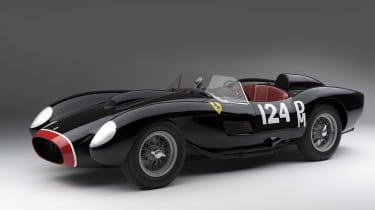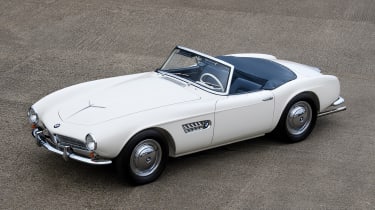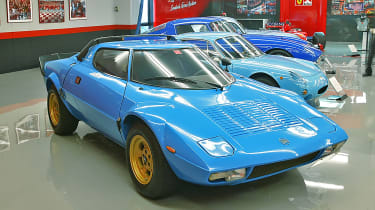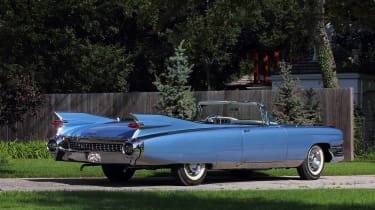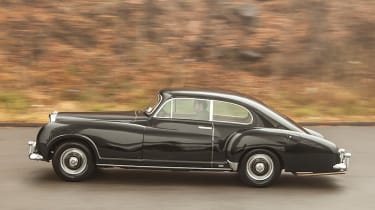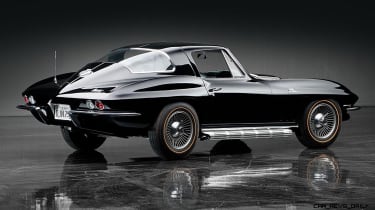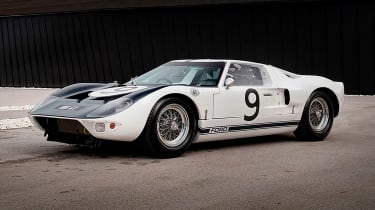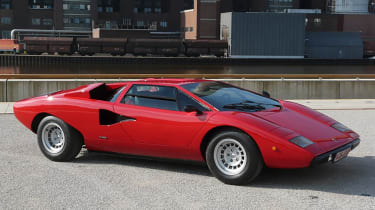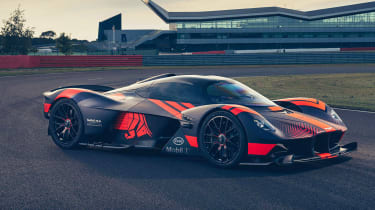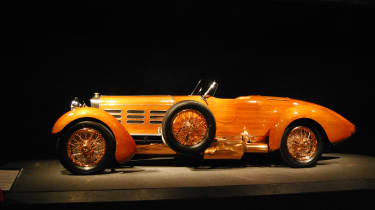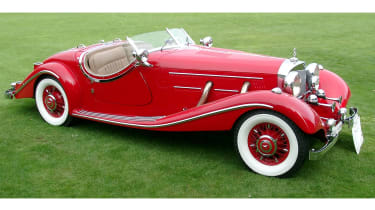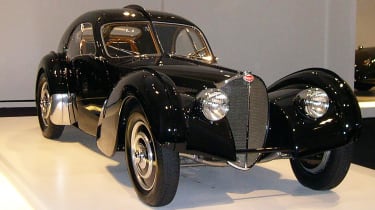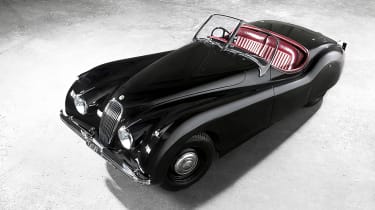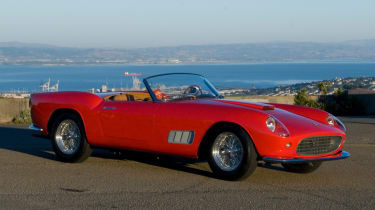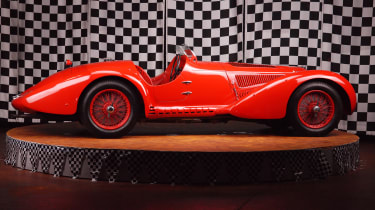The world's most beautiful cars (25-1)
We pick the top 25 most beautiful cars of all time
Welcome to the final 25 in our pick of the top 50 most beautiful cars in the world. Scroll down to see the cars or jump back to page 1 for numbers 50 to 25...
25. Facel Vega Facel II
- Years produced: 1961 to 1964
It was advertised as the fastest four-seater coupe in the world, thanks to a 135mph maximum speed claimed from a 6.3-litre Chrysler V8 engine, but the luxurious and expensive Facel II was most notable for the elegance of its aluminium coachwork.
The car wasn’t short of famous owners, with Pablo Picasso, Christian Dior, Tony Curtiss, Ava Gardner, Princess Grace of Monaco, Frank Sinatra, Ringo Starr, The Shah of Persia and Stirling Moss among the glittering celebrity names who succumbed to the short-lived marque’s undoubted charms.
Sadly, that wasn’t enough to keep the French manufacturer afloat, and Facel Vega folded in 1964 - after only 180 examples of the Facel II had been produced - due to an ill-fated venture into engine manufacturing.
The car pictured was bought by Ringo Starr in 1964 for £5,000, a price equivalent to that of a contemporary Rolls-Royce Silver Dawn.
24. Mercedes 710 SSK Trossi Roadster
- Year produced: 1930
The Mercedes SSK was one of the most glamorous cars of the late 1920s and ‘30s, not to mention one of the most highly rated sporting machines of its time. It was designed by Ferdinand Porsche as his last hurrah for Mercedes before leaving to set up on his own.
Most SSKs were bodied in-house with lightweight racing bodies, but this one purchased by Count Carlo Trossi - a future president of Scuderia Ferrari - was rebodied to what is believed to be his own design in 1930.
The car’s fabulous tear-drop styling cues were copied widely by European coachbuilders in the 1930s, and the trend-setting Trossi Roadster now resides in the Ralph Lauren collection. It was restored in the 1990s, after which it won several important international concours d’elegance competitions.
23. Audi TT (Mk1)
- Years produced: 1998 to 2006
The Audi TT began life at the VW Group’s California Design Centre in 1994, and it helped to reinvent Audi’s sporting image from the moment it was revealed as a concept at the Frankfurt Motor Show in 1995.
With inspiration from classic NSU and Auto Union racing cars from as far back as the 1930s, the TT managed to look both retro and futuristic all at once, and the clamour of approval from the media and public led to Audi launching a production model in 1998.
A mark of the design’s integrity was that the production car arrived looking remarkably similar to the concept, and that famous TT profile became instantly recognisable across successive generations of the car.
22. Citroen SM
- Years produced: 1970 to 1975
The Citroen SM was an imaginative attempt by the French firm to harness the high-performance potential of its ground-breaking chassis technologies, and its modernist styling was an accurate reflection of the model’s forward-looking character.
Features such as variable power-steering assistance, rain-sensitive wipers and even composite wheels were all on the SM spec list, but it’s surely the car’s styling that most endears it to a legion of fans.
Citroen’s head of design Robert Opron took credit for the SM, which has cues from the Citroen CX but in a teardrop form with an abruptly truncated Kamm-style rear end. Power came from a Maserati V6 - Citroen bought the Italian firm in 1968 - and the media raved about the SM’s effortless cruising ability. However contemporary customers seem to have been put-off by the car’s complicated technologies, and production ended abruptly in 1975.
21. Duesenberg Model J
- Years produced: 1928 to 1937
People don’t say ‘it’s a doozy’ much anymore but, when the phrase was coined as an expression of excellence, the Duesenberg Model J was the car it referenced.
The Model J was sold between 1928 and 1937 when the company folded, and was revered as one of the most powerful and luxurious cars in the world, with a level of technology and craftsmanship that rivalled the likes of Rolls-Royce and Hispano-Suiza.
Power came from a seven-litre straight eight engine, offered with 320bhp via supercharging from 1932 and a top speed of 140mph, but the impact and after-effects of the Great Depression constrained sales of this magnificent machine. Nonetheless, notable owners included Howard Hughes, Clark Gable, Greta Garbo and the Duke of Windsor, as well as Al Capone.
20. Aston Martin DB4 GT
- Years produced: 1959 to 1963
New for 1959, the sensational Aston Martin DB4 featured an aluminium fastback GT body designed by Italian masters Carrozzeria Touring. The car’s style met with much critical acclaim, while a 3.7-litre 240bhp straight six engine and disc-brakes all round meant performance was rewarding too.
A lightweight race-focused version of this fabulous machine was introduced later the same year, dubbed the DB4 GT. It had more power, with an engine upgraded to 302bhp, and a slightly shorter wheelbase to improve handling, while the body was made of thinner alloy to reduce weight.
75 examples were built, and as one of the most desirable Astons ever, it’s not surprising that the firm decided to build a series of 25 track-only ‘continuation cars’ for wealthy collectors in 2016. However the rarest and most expensive are the handful of original DB4 GT Zagatos, modified in Italy with a new grille and rounded-off rump.
19. Porsche 356 Speedster
- Years produced: 1954 to 1958
Porsche’s first production sports car was the 356, which was built from 1948 until the arrival of the 912/911 models in 1965. Originally developed as a coupe, the 356 was offered in Speedster guise from 1954 at the behest of US importer Max Hoffman. Porsche responded with the wonderful Speedster model, with its famously low raked windscreen and bucket-seat interior, and the model was an instant success,
Part of the 356 Speedster legend is the car’s association with 1950s movie hearthrob James Dean, but the little Porsche is undoubtedly photogenic in its own right. Various homages to the 356 Speedster include the very many replicas built over the years, as well as the highly collectible Speedster editions of the Porsche 911.
18. Jaguar E-Type
- Years produced: 1961 to 1975
Famously described by Enzo Ferrari as the most beautiful car ever made, the Jaguar E-Type was developed from the D-Type racing car that won three times at Le Mans.
Such was its success that the E-Type survived over three generations from 1961 to 1975, originally in 3.8-litre six-cylinder guise, then with a 4.2-litre six, and for the final Series 3 variant Jaguar’s 5.3-litre V12. Coupes and convertible versions were offered, but the most highly-prized cars these days are the early Series 1 models which are generally considered the prettiest thanks to their simpler, purer design.
Such is the enduring appeal of the E-Type’s design, that in 2020 Jaguar announced plans to revive the model with an all-electric drivetrain - the E-Type Concept Zero.
17. Alfa Romeo Carabo
- Year produced: 1968
It’s hard to imagine that Alfa Romeo struggled to sell its full complement of T33 Stradale supercars back in the 1960s, but were it not for that fact we’d never have been treated to the outrageously futuristic wedge-shaped Alfa Carabo concept.
Alfa handed over five of these now highly collectible machines to Italian coachbuilders, and Bertone revealed its stunning Carabo at the ‘68 Turin Motor Show. It was one of the very first wedge designs to see the light of day, and surely one of the prettiest. Thanks to its T33 underpinnings the Carabo was/is a fully working machine, but at only 39-inches high it’s not very practical. But who cares, just look at it!
16. Dodge Charger R/T (Mk2)
- Years produced: 1968 to 1970
With Dodge dealers clamouring for a sporty coupe rival to the Ford Mustang in 1965, company bosses didn’t want to muddy the waters for sister company Plymouth which already had the Mustang-fighting Barracuda. So instead they went for something the next size up - and the Dodge Charger was born.
Early models were successful, but a rebody in 1968 brought a new look with classic ‘coke bottle’ styling and a flying buttress rear windscreen. A moody full width grille with hidden headlights was carried over from the previous generation Charger. Best of all though, was a new Road/Track package featuring muscular 440 Magnum or 426 Hemi V8s and ‘bumble-bee’ stripes around its bootlid - pure muscle car pornography.
15. Ferrari 250 Testa Rossa
- Years produced: 1957 to 1962
It’s not surprising that some of the most collectible - read expensive - classic cars of all time are also the most beautiful. The racing Ferrari 250 Testa Rossa is one model that ticks both boxes, being extraordinarily rare and eye-wateringly pretty.
The aluminium bodied roadster was the follow-up to the successful 750 Monza, and featured Ferrari’s then state-of-the-art 3.0 V12 Colombo engine shoehorned under its tautly sculpted bonnet. In its hey-day the 250 TR won 10 World Sportscar Championship races including three Le Mans 24hrs and the Targa Florio.
Just 22 examples of the 250 TR were built, the early cars with bodies by Scaglietti featuring unmistakable ‘pontoon’ front wings either side of an F1-style nose. From 1959 Pininfarina revised the body for greater aerodynamics with a swoopy sportscar style front end.
14. BMW 507
- Years produced: 1956 to 1959
BMW has built many fine cars over the years, but arguably none as pretty as the 507 Roadster, a car so glamorous it attracted the attention of buyers including Elvis Presley, Fred Astaire, John Derek and King Constantine II of Greece.
In production from 1946 to 1960, only around 250 examples of the V8-powered 507 were sold, mainly because it ended up being far more expensive to build than BMW had planned. The roadster was conceived at the behest of the US importer who wanted a BMW to take on the Mercedes 300SL, but with a handbuilt aluminium body the 507’s selling price was double what the market would stand. In fact, the 507 nearly bankrupted BMW, offering industrialist Harald Quandt his chance to take control of the company - his children still own a majority stake.
13. Lancia Stratos HF Stradale
- Years produced: 1973 to 1975
One of the most iconic shapes on the 20th Century world rally stage was the fabulous Lancia Stratos, a car built to win the World Rally Championship which it promptly did in 1974, ‘75 and ‘76 with Sandro Munari at the wheel.
The Stratos was the result of a bold move by coachbuilder Bertone to pinch Lancia’s business from its traditional partner Pininfarina, and the wedge-shaped coupe with its iconic wraparound windscreen, penned by Bertone’s designer Marcello Gandini was both audacious and stunning. The Stratos was powered by a mid-mounted 2.4-litre Ferrari V6 engine designed originally for Ferrari’s own Dino, and nearly 500 road-going versions were built for homologation purposes. The survivors are highly collectible, and the Stratos has inspired many replicas too.
12. Cadillac Eldorado (Mk4)
- Years produced: 1959 to 1966
For lovers of finned Americana, things don’t get much better than the fourth-generation Cadillac Eldorado series introduced in 1959.
For starters, automotive fins don’t get much bigger, and in the case of the gigantic Eldorado land yacht, they served as the perfect mounting point for Cadillacs iconic rocket tail-lamps. A little excessive perhaps for some tastes, but the Eldorado fuelled the American dream for many, and sales of the 5.7-metre, 2.4-ton convertible proved the point.
Aside from its extravagant exuberances, the ‘59 Caddy marked a move to a wider, lower stance than its predecessors, inspired by the success of a similar design shift at Chrysler.
11. Bentley R-Type Continental
- Years produced: 1952 to 1955
Formerly the fastest four-seat passenger car in the world, and in its day probably the most expensive, the magnificent R-Type Continental set the standard for British car manufacturers in the early 1950s.
It was based on the R-Type ‘standard steel’ saloon chassis, but featured an upgraded 4.5-litre straight-six engine offering speeds of up to 120nph. The bodies were all coachbuilt, mostly by H.J. Mulliner, to a lightweight fastback designed influenced by the latest aerodynamic testing in the Rolls-Royce wind tunnel.
It’s a rare and beautiful machine, with just 208 chassis numbers recorded, and only a handful of R-Type Contis had bodywork from external suppliers. One such is the wonderful Franay bodied example pictured, recently sold at auction by Bonhams.
10. Corvette Stingray (C2)
- Years produced: 1963 to 1967
Sports car fans don’t tend to rate the handling of the Chevy Corvette compared to European rivals - it was named after a class of warship after all. From an aesthetic point of view though, the Corvette has always delivered, and perhaps never more so than in the guise of the iconic split-window coupe variant, aka the original Stingray.
1963 was the year Chevrolet introduced its MkII Corvette, and the coupe variant was a first. The styling was overseen by GM’s design guru Bill Mitchell, and while he considered the twin-pane rear screen essential, it was dropped a year later for a single rear window.
The ‘63 Stingray coupe has since become one of the most collectible of Corvettes, and you’ve only to look at it to see why.
9. Ford GT40
- Years produced: 1964 to 1969
When Ford decided to take on Ferrari at Le Mans with a GT car, it turned to British racing car maker Lola for its chassis tech, added its own 289-cubic-inch/4.7-litre V8 engine, and draped it in a low-slung aluminium body with a roof height 40 inches above the ground - the maximum height allowed for international endurance racing.
That in a nutshell is how the now legendary GT40 arrived, and with the help of Carrol Shelby and a roster of star drivers, the name was etched into history by winning Le Mans four times in succession from 1966 to 1969.
It may be coincidental, but the GT40 also happens to look drop-dead gorgeous, which surely helps account for the multi-million pound price-tags achieved for cars like this early prototype GT40 sold in 2020 by Duncan Hamilton/Rofgo.
8. Lamborghini Countach (Mk1)
- Years produced: 1974 to 1990
Many enthusiasts prefer the original Countach LP400, which first introduced Italian coachbuilder Bertone’s startling and spectacular ‘wedge’ design to bedroom wall posters around the world. However, who could deny the visceral desirability of the LP400 S? This design put Bertone’s work on steroids with its fat wheel-arches covering the widest-available-anywhere Pirelli rear tyres, especially when buyers specified that mighty but optional ‘flying-vee’ rear wing.
Such was the impact of the wedge design with its rakish screen and trademark scissor doors, that the theme has been developed for Lamborghini’s top flight supercars all the way to the present day Aventador, not to mention recent one-off and limited edition models such as the Reventon, Veneno and Sian.
7. Aston Martin Valkyrie
- Years produced: 2021 to present
The recent trend for ultra-high-performance cars often results in exterior design that’s more focused on performance than aesthetics. The Aston Martin Valkyrie transcends the genre by managing to look beautiful while incorporating technology that wouldn’t be out of place on a futuristic jet fighter.
It’s a machine designed primarily to cleave the air in the manner of an F1 car, and which features an incredible cut-away ‘venturi effect’ underfloor to go with its mind-blowingly powerful circa 1,000bhp V12 engine, but the Valkyrie’s carefully-finessed curves are as drop-dead gorgeous as you’d expect from any modern Aston road car.
With production of the first road-going Valkyries slated for 2021, it will be fascinating to see how customers spec their cars.
6. Hispano H6B ‘Tulipwood’
- Year produced: 1924
The name Hispano-Suiza is revered amongst aficionados of luxury cars built between WWI and WWII, and its imposing H6 model was produced from 1919 right up to 1933. The company was renowned for its technically advanced approach, including lightweight aviation-inspired engines and power-assisted brakes - an industry first.
The H6B was the most powerful eight-litre variant, inspiring the build of five racing versions, one of which set international speed records including a 92mph average over 300 miles at Brooklands in 1924. The fabulous H6B Tulipwood was a racer entered in the 1924 Targa Florio, for which its driver Andre Dubonnet demanded a bodyweight of less than 45kgs. The result was this stunning wooden-strip torpedo roadster.
5. Mercedes-Benz 540K Spezial Roadster
- Years produced: 1936 to 1940
The Mercedes-Benz 540K was a stunning supercharged monster unleashed by the German firm in 1936, and while it was available in a variety of cabriolet, touring and limousine configurations, none were as glamorous and desirable as the Spezial Roadster version. This ultimate symbol of pre-war automotive decadence features a flowing long-tail two-seater body, and an inline eight-cylinder engine with a driver-operated supercharger for added performance.
At the time, while it was customary for many luxury cars to feature bodywork commissioned by owners from third-party coachbuilders, Mercedes at Sindelfingen employed a large team of in-house craftsmen to create bespoke commissions. Nowadays the 540K Spezial Roadster is one of the most prized and collectible models in the world.
4. Bugatti Type 57 Atlantic
- Years produced: 1936 to 1938
Art Deco lovers drool over the lines of this swoopily-fendered and finned coupe derivative of the Bugatti Type 57 touring model. Just four Atlantics were built in the late 1930s, following the reveal of Jean Bugatti’s similar Aerolithe show car at the Paris Salon in 1935.
The prototype was bodied in a magnesium alloy called Elektron, which was lightweight but flammable at high temperature so couldn’t be welded. Body panels were riveted instead, with the fasteners prominent on the car’s now iconic dorsal fin. The four Atlantic coupes produced in the likeness of the Aerolithe were bodied in aluminium, but retained the visible rivets.
3. Jaguar XK120
- Years produced: 1949 to 1954
Jaguar was on a roll in the late 1940s, on the brink of its first couple of Le Mans wins in the early ‘50s and eager to build on increasing post-war demand for indulgence and fun times. It responded at the 1948 London Motor Show with a swoopy two-seat roadster model intended originally as a showpiece for its new XK six-cylinder engine. The car met with such acclaim that it went into production immediately as the XK120 - named for the car’s top speed in MPH with the windscreen removed.
Available as a roadster, but also in fixed- and drop-head coupe guise, the XK120 evolved into XK140 and XK150 models, and was the precursor to the E-Type. The early XK120 roadsters are considered the most beautiful of the bunch by enthusiasts, who feel later cars with their beefier bumpers lost some of the original design ‘purity’.
2. Ferrari 250 GT California Spyder SWB
- Years produced: 1960 to 1963
Ferrari has a long back catalogue of impossibly glamorous cars, but the Ferrari 250 GT California Spyder is one of the most desirable of all time thanks to its beautiful open two-seater body created by the coachbuilding wizards at Scaglietti. In truth, any of the Ferrari 250 sports and racing cars deserve a place on this list, as the three-litre V12-powered series includes such luminaries as the 250 Testa Rossa and 250 GTO to name a few.
The California variant was designed for the US market as its name suggests, and a long-wheelbase version introduced in 1957 was superseded by the even-lovelier short-wheelbase in 1960 which benefited from disc brakes and an uprated 276bhp version of the V12.
1. Alfa 8C 2900 Mille Miglia
- Years produced: 1937 to 1939
There have been many beautiful Alfa Romeos over the years, but one of the highlights from a spectacular historic portfolio is the car that won the famous Mille Miglia Italian endurance race in 1938. The 8C 2900 was derived from Alfa’s 8C Grand Prix car, and featured an 8-cylinder inline 2.9-litre engine with twin superchargers.
The factory Alfa Corse racing team entered four in the 1938 Mille, including this one running the latest Tipo 308 295bhp Grand Prix engine, It was piloted by Clemente Biondetti to victory, with another 8C 2900 MM in second – the other two didn’t finish. The drop-dead gorgeous roadster bodywork of the MM racers was by Carrozzeria Touring Superleggera.
So there you have it, our top 50 most beautiful cars of all time. Tell us about any you think we've missed in the comments...

